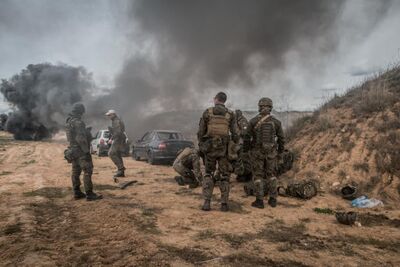Operation Sagaris
| Operation Sagaris | |||||||
|---|---|---|---|---|---|---|---|
| Part of Zemplen War | |||||||
 Syaran troops tend to the wounded after their defeat. | |||||||
| |||||||
| Belligerents | |||||||
|
|
| ||||||
| Commanders and leaders | |||||||
|
|
| ||||||
| Units involved | |||||||
| Army Group South | Army Group Gamma | ||||||
| Strength | |||||||
| 850,000 troops | 600,000 troops | ||||||
| Casualties and losses | |||||||
|
26,780 killed 80,000 wounded |
28,405 killed 76,366 wounded | ||||||
Operation Sagaris (known sometimes as the Battle of the Kenderes Steppe) was an offensive launched by the Syaran Commonality Armed Forces during the Zemplen War. With more than half a million troops involved on each side, it was the largest single battle fought in the conflict.
In the spring of 2009 Syara had launched Operation Synaspismos and delivered a crushing victory against Ruvelka's Army Group South. Despite the failure to capture Aszód and the Operation Pylooros, Syaran Central Command believed a sweeping offensive into the Ruvelkan steppe south of the Matra Mountains would allow Syara to circumnavigate the mountainous obstacles of the Kurillas and allow the Syarans to push into eastern Ruvelka. Field Marshal Daniel Mladenov Todorov, commanding officer of Army Group Gamma, envisioned a major encirclement of the bulk of Army Group South to destroy Ruvelka's main fighting force in the region, with the added bonus of cutting off the supply routes from Ruvelka-aligned Mansuriyyah, which flowed through the city of Kenderes. Recognizing the danger, the Ruvelkan Imperial General Staff hundreds of thousands of reinforcements into the region, boosting Ruvelkan troop numbers to over 800,000 men and women. Army Group Gamma fielded some 600,000 troops in addition to nearly 4,000 tanks and an additional 8,500 armored vehicles, many of them donated from units from Army Group Beta.
The Syarans began their offensive on 17 April 2009, expecting that the wide open steppe would be well suited to their mechanized forces and maneuvers, but stiff Ruvelkan resistance resulted in limited gains for the first few weeks. In response the Ruvelkans executed a phased withdrawal on 28 April, allowing the Syarans to overextend themselves before launching a major counterstroke with the Eleventh and Fifteenth Armies. Devesated by Ruvelkan helicopter gunships, Syaran armor was unable to achieve a breakthrough and was forced to retreat. A Ruvelkan counter-offensive forced the Syarans back to the foothills of the Matra Mountains, and the fighting died down around 7 May.
The Syaran defeat came as a suprise to both Syaran and Ruvelkan commanders, who expected that the Syarans would enjoy a significant advantage in the open steppe compared to the thick forests and rugged mountains of much of the rest of Ruvelka. In the aftermath of the operation, Field Marshall Todorov came under fire from the SCAF for his poor planning and leadership during the course of the battle, though he ultimately remained in command of Army Group Gamma for the remainder of the war. The losses Syara suffered during the campaign, coupled with casualties during the Battle of Sagerejo and Operation Harpe led Central Command to suspend further major offensives a few months later.